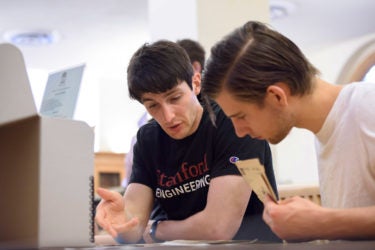On a recent Wednesday morning, students read and studied for exams in the usual quiet sections inside Stanford’s Green Library.
The library’s Barchas Room, however, buzzed with activity.
There, about a dozen students gathered for History of Modern China, one of the undergraduate classes at Stanford that now provides hands-on opportunities to work with historical documents and artifacts.
Students were confronted with six gray boxes containing hand-written letters, diaries, official documents, black-and-white photographs and other items from around the 1960s related to China. Teaching assistant Peter Hick, who curated the archival materials for the class along with Stanford historian Tom Mullaney and the Stanford University Libraries staff, reminded the group to take care when handling the archives – a box of gloves and a bundle of paper weights resided in the corner of the room – and to document which materials were removed.
The students, in groups of two or three, then gathered around the boxes and dug in.

Image credit: L.A. Cicero

Image credit: L.A. Cicero

Image credit: L.A. Cicero

Image credit: L.A. Cicero

Image credit: L.A. Cicero
Under Associate Professor Mullaney’s direction, similar hands-on, archival experiences are being brought to other large undergraduate courses. The goal is to simulate what professional historians do and expose more students to the rich special collections available to them on campus.
Many Stanford students praised the new teaching approach.
“It’s amazing how much information is stored here at Stanford, and we have it at our fingertips,” said junior Jessie Dalman.
As a history major, Dalman has visited the archival sections at the Hoover Institution and at the Stanford University Libraries numerous times. She said many of her fellow students probably do not know about those resources, which is why classes like History of Modern China are important.
“Sifting through archival materials makes you feel more personally involved,” Dalman said. “It’s like you’re discovering history in class.”
Mechanical engineering junior John Chuter took Mullaney’s class to fulfill a program requirement. Chuter, who had never visited Stanford’s archives, said he was glad he picked this particular class.
“It’s been eye-opening,” Chuter said. “I didn’t expect to come across so many interesting things.”
Chuter said he gained a different perspective on history through the examination of the special collections. One memorable discovery came from reading a soldier’s letters. He said he was struck by the banality and simplicity of the writer’s language as he described the turbulent events of his time.
“Special Collections allow us to both view history in a perspective of somebody living inside it, but also makes us view ourselves as if we were living in history,” Chuter said.
History of Modern China was the first history class Natasha Field-Marsham took at Stanford, and it was also her first time exploring the special collections.
Field-Marsham, who is majoring in international relations with a concentration in economic development in Asia, said most of her studies involved using digitized and current materials, such as newspaper and online journal articles.
She compared the hands-on archival experience to going on a treasure hunt.
As part of Mullaney’s class, students had to research a topic and find relevant materials in the special collections. Field-Marsham said she checked out four archival boxes as part of her research on early 20th-century Chinese bonds, spending hours examining letters, official documents and other primary sources. Three of the four boxes did not have any materials relevant to her research, but the process taught her a lot, she said.
“You kind of just follow this trail, jumping through time and continents,” Field-Marsham said. “It was frustrating at times, but fun. It felt like an adventure.”
Field-Marsham said the archives may be intimidating to students who never had to use them before. She said having classes that embrace a gradual introduction to special collections with the help of professors and teaching assistants is important.
“Mullaney’s class presented the archives to us in a very hand-holding way, which makes further archival research into your own projects much more effective,” Field-Marsham said.
Senior Rishi Bedi took History of Information, which piloted Mullaney’s new archival approach in spring 2016. Sifting through the archives could be a tedious process, Bedi said, echoing other students, but the experience was ultimately rewarding for him.
Bedi, who is majoring in computer science, researched the lives and work of American architect Richard Buckminster Fuller and computer scientist Edward Feigenbaum as part of the class.
“I remember feeling pretty overwhelmed,” Bedi said. “But it was so gratifying when I did find things.”
In addition to his computer science studies, Bedi is pursuing a minor in history. He said it’s important for students, especially those in technical fields, to dedicate time to subjects like history and other humanities.
“I’m totally the type of person who can get engrossed in a CS assignment,” Bedi said. “But if you want to do something worthwhile in this world, it’s valuable to know what happened before you … it’s important for me to exercise other parts of my brain.”